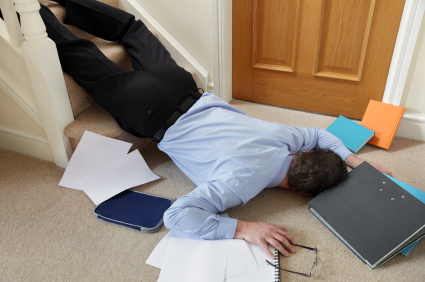How to prevent slipping or stumbling while using the stairs.
Are you responsible for safety at work or your own company? Then read this article with my recommendations on what to do about unsafe situations.
You often hear and read in the news about people falling due to a slippery staircase or slippery floor, sometimes with serious consequences. Often for some reason insufficient attention is paid to this. A serious fall must take place before anything is done about the situation.
Whether at home, at work, or in public buildings, almost everywhere there is a staircase or a floor that can be slippery. Especially if it is damp due to rain, the surface often becomes quite slippery. If you want to do something about this, take a critical look at your environment and analyze where there is a dangerous situation, for example things on the stairs that prevent you from walking properly.
Narrow steps so that you cannot put your foot down optimally, locations where the stairs are often damp, the lack of banisters so that you lack extra support to go up and down the stairs. Those are some of the unsafe situations I speak about. A small step in the shop or at the office, the marble stairs to the bicycle cellar in the hotel, there are quickly many places that require a solution.
They did this at the van der Valk hotel in Dwingeloo, an employee of the technical service started an analysis and came to the conclusion that the natural stone stairs to the bicycle cellar became slippery during rain. A good adhesive non-slip strip quickly provided a good solution.
There are a number of options to adjust an unsafe situation:
- Applying a non-slip strip
- Placing anti-slip corner profiles
- Applying a non-slip coating
- Assembling tools
- Applying a non-slip strip
Applying a non-slip strip
When it comes to the stairs, the steps are often slippery, especially if the steps have a hard surface such as concrete or natural stone, or your freshly painted staircase in the house. A hard surface gives more smoothness to the steps. A non-slip strip that you can stick, or a strip that is clamped in a groove is the best solution.
If the stairs are used a lot, such as in shops, office buildings or catering establishments, a non-slip strip that you can stick is a quick, durable and effective solution. An sandpaper anti-slip tape is not suitable for this. It is too thin and wears out quickly. A stair strip with a thickness of approximately 2 mm is best. Preferably as wide as possible for the best anti-slip result.
Placing anti-slip corner profile
There are aluminum and plastic corner profiles for sale that you can glue or screw to the front of the steps. These strips also give a very good result for making steps outside and on the outside safer. These corner profiles are also very suitable for outdoor situations. The aluminum strips have a ribbed structure to ensure that a good grip is maintained in a humid environment.
Applying a non-slip coating
Anti-slip coatings are widely used in catering establishments and public buildings where there are stone or concrete stair portals. The coating is applied with a roller or a spray installation, the result is very good, although the life is short. So you will have to do this regularly. Nowadays there is also a stair varnish to make your painted stair treads stiff, the results for this are variable, but if you have a painted staircase, a stair varnish can be applied.
Assembling tools
Make sure there is an opportunity to find support or balance when climbing stairs, place a bracket on dangerous parts, or a good strong railing that is 40mm round over the entire walking part is the best solution. Unfortunately, there is often not enough space to place a banister, especially in catering establishments, for example when you go to the toilet, a proper banister is often missing.
Assembling tools
Make sure there is an opportunity to find support of balance when climbing stairs, place a bracket on dangerous parts, or a good strong railing that is 40mm round over the entire loop part is the best solution. Unfortunately, there is often not enough space for placing a banister, especially in catering establishments, for example when you go to the toilet, a powerful banister is often missing.
Guest blogger: Johan
Definitely worth reading:










Comments
Login to give reaction Your comment will be posted as soon as it is approved.